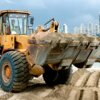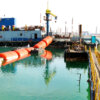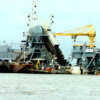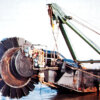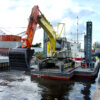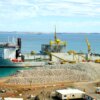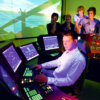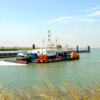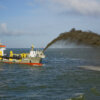Dredging Equipment: Its evolution, capabilities and importance for maritime infrastructural works.
SUMMARY
Over the last 50 years the size of dredging equipment has grown tremendously. The current generation of hoppers, cutters and backhoes has enabled the construction of large maritime infrastructural works within a short execution time.
The investments in dredging vessels demonstrate the understanding that dredging contractors have for the ever increasing need for bigger ports and larger deep water land reclamations.
After the first jumbo trailer was built in 1994, eight more of these huge trailing suction hopper dredgers were built over the next six years.
By the year 2000, 33,000 cubic metre so-called ‘mega’ dredgers were operational, i.e. their carrying capacity had doubled in almost ten years’ time.
Whereas the maximum cutter power installed on cutter suction dredgers was about 3,000 kW in the seventies of the last century, nowadays the largest cutter suction dredgers have cutters powered by 8,000 kW engines. Now, the construction of ports and approach channels in strong rock has become possible.
In addition, the much larger pump capacity installed on these vessels, in combination with their high cutter power, have also reduced the construction time in softer materials. Backhoes with buckets of 40 cubic metre are no exception. So, dredging consistent material at narrow places with a high accuracy has become feasible.
FOR WHOM
Follow this webinar to learn all about the capabilities and the importance of these 3 prime movers of the modern dredging industry.
LEVEL
Previous knowledge is not required.
THE SPEAKER
Frans Uelman graduated with an M.Sc. in Civil Engineering and started his professional career as a research engineer and production estimator with Costain Blankevoort Dredging Company in 1978.
During the late seventies and the early eighties, he worked on many dredgers as a trouble-shooter, meanwhile developing data acquisition systems for the gathering of unbiased process data.
After having been employed for a few years by a company, specialised in the automation of dredging processes, he joined Boskalis in 1987. He started as a research engineer and from the early nineties until 1998 he was a member of the soils group of the estimating department, and therefore involved with soil investigations and soil related studies.
Then, Frans joined Hydronamic bv, Port & Waterway Engineers, a subsidiary of Boskalis where he specialised in geotechnical matters related to dredging and reclamation. Since 2000 he has managed design and engineering work for tenders and projects. As such, Frans managed all technical and environmental matters related to the Channel Deepening Project in Melbourne Australia during tender, preparation and execution between 2003 and 2009.
For the Gorgon project that followed thereafter, he prepared the environmental and quarantine plans.
Since 2010 Frans is based at the Boskalis head office in the Netherlands. He has been lecturer and course coordinator of the IADC Dredging Seminar for more than 15 years.


